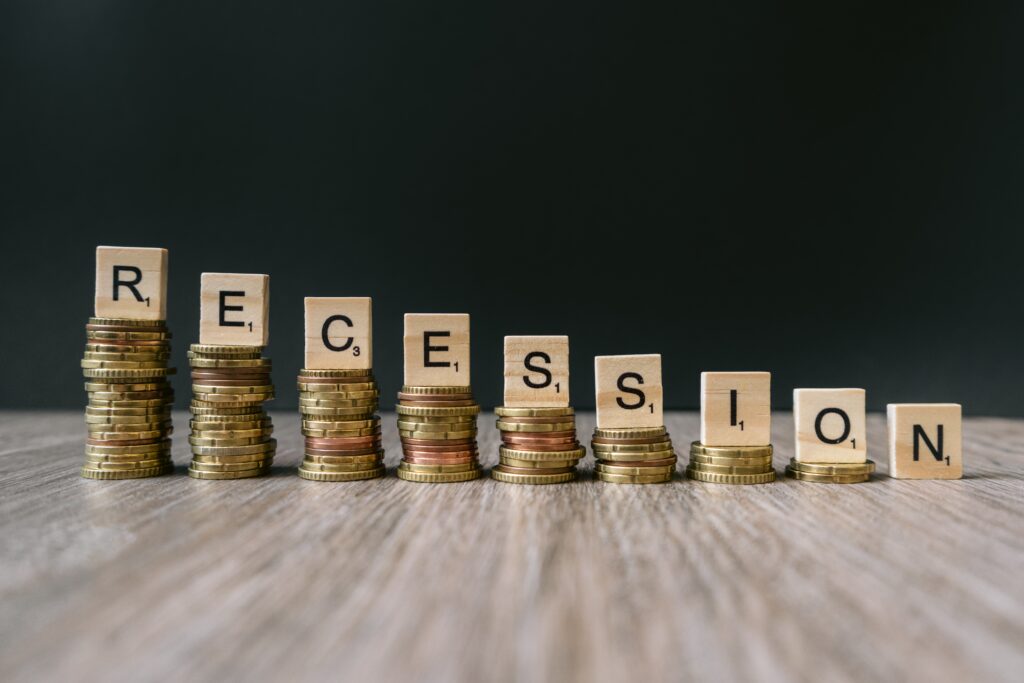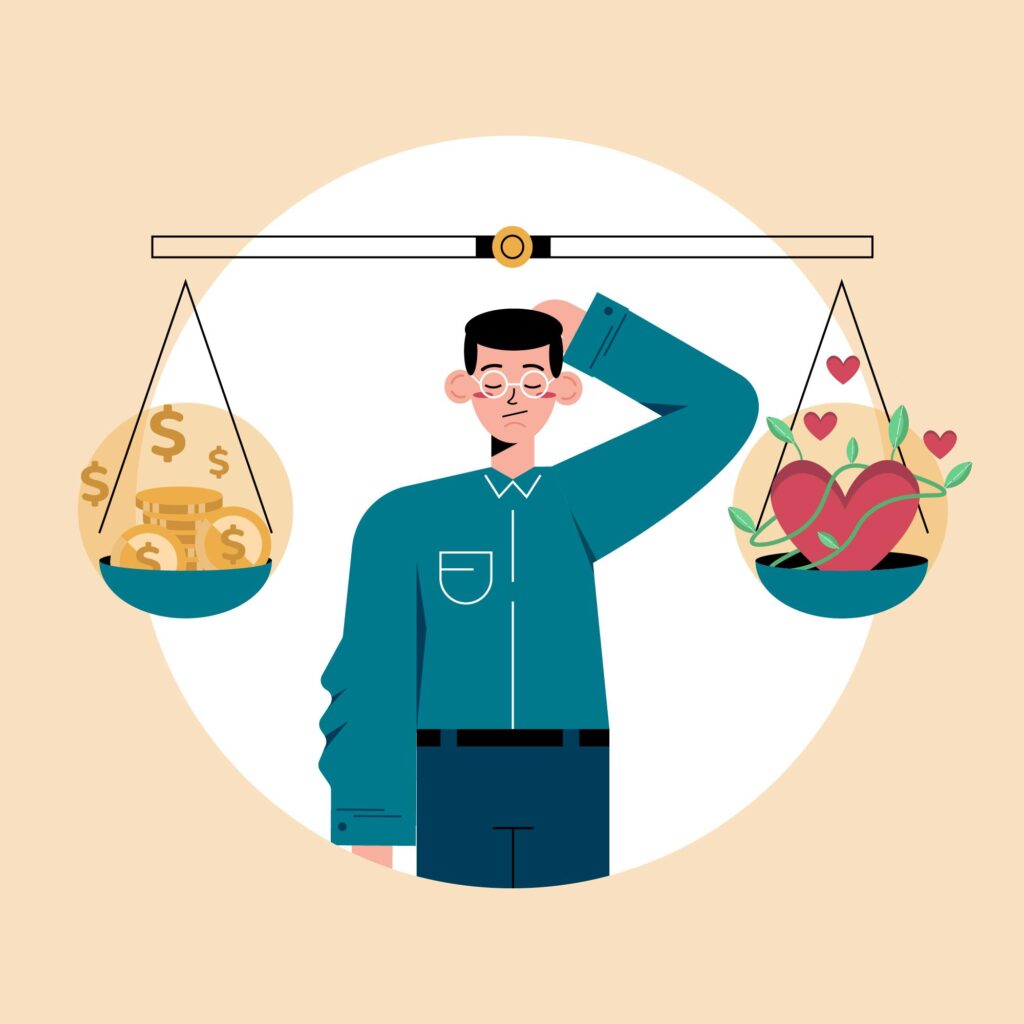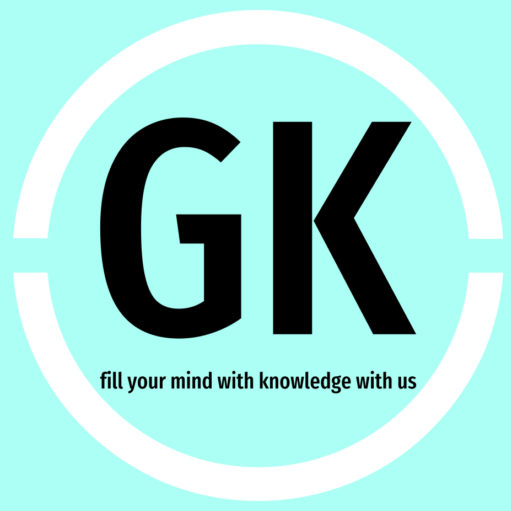
Table of Contents
What is Recession?
A recession is an economic downturn characterized by a significant decline in economic activity throughout the economy. During a recession, there is typically a contraction in gross domestic product (GDP), which measures the total value of goods and services produced in a country. This decline in economic activity often leads to rising unemployment, decreased consumer spending, decreased business investment, and a general slowdown in economic growth.
Economic recession can arise from various factors, such as:
Tight monetary policy: Central banks may raise interest rates to control inflation, which may reduce borrowing and spending by businesses and consumers.
Changes in fiscal policy: Government policies such as tax increases or spending cuts can reduce disposable income and reduce aggregate demand in the economy.
External shocks: Events such as financial crises, natural disasters, geopolitical conflicts or pandemics can disrupt economic activity and lead to recession.
Recessions can have widespread negative effects on individuals, businesses, and governments, leading to lower incomes, bankruptcies, and budget deficits. Governments and central banks often implement measures such as monetary stimulus (lowering interest rates) and fiscal stimulus (increasing government spending) to mitigate the effects of recession and promote economic recovery.
Understanding Recession
Understanding recessions involves understanding their causes, characteristics, and effects on various aspects of the economy. Here’s an analysis:
- Causes of Recession: A recession can be triggered by a variety of factors, including:
- Monetary Policy: To combat inflation, central banks may raise interest rates, which may reduce borrowing and spending, leading to a slowdown in economic activity.
- Fiscal Policy: Government policies such as tax increases or spending cuts may reduce consumer and business spending, which may affect economic growth.
- External shocks: Events such as financial crises, natural disasters, geopolitical conflicts or pandemics can disrupt economic activity and lead to recession.
- Features of Recession: During a recession, several key indicators exhibit negative trends:
- GDP contraction: Economic output, measured by gross domestic product, falls for two consecutive quarters or more.
- Unemployment: As businesses cut costs, jobs are shed, causing the unemployment rate to rise.
- Consumer Spending: Due to economic uncertainty, consumers reduce spending on non-essential goods and services.
- Business Investment: Companies may delay or cancel investment projects due to low demand and financial constraints.
- Property Prices: Stock markets may experience declines, and housing markets may stagnate or decline.
- Effects of Recessions: Recessions can have wide-ranging effects on individuals, businesses, and governments:
- Income loss: Workers may face layoffs, reduced hours, or pay cuts, leading to reduced income levels.
- Business Failures: Some companies may go bankrupt due to declining sales and revenues, leading to job losses and economic instability.
- Financial Stress: Individuals and families may struggle with loan repayments, mortgage defaults and foreclosures.
- Government Budget: Tax revenues decline, while spending on unemployment benefits and social services increases, leading to a budget deficit.
- Psychological impact: Recession can cause anxiety, stress and uncertainty among people, which can affect consumer confidence and spending behavior.
- Policy Responses: Governments and central banks often implement measures to mitigate the impact of recession and promote economic recovery:
- Monetary Stimulus: Central banks can lower interest rates, engage in quantitative easing, or provide liquidity support to banks to encourage borrowing and spending.
- Fiscal stimulus: Governments can increase spending on infrastructure projects, provide tax cuts or exemptions, and provide financial assistance to individuals and businesses.
- Regulatory measures: Authorities can impose regulations to stabilize financial markets, prevent systemic risks, and address vulnerabilities in the economy.
Understanding these aspects of recession is important for policy makers, economists, businesses and individuals to effectively deal with economic challenges and promote sustainable growth and prosperity.
What is the Recession Forecast?

Predicting a recession is complex and often involves analyzing various economic indicators, trends, and factors. Although no single indicator can reliably predict a recession, some warning signs and patterns are commonly observed:
- Yield Curve Inversion: When the yield curve, which plots the yields of government bonds with different maturities, inverts (short-term interest rates are higher than long-term rates), it is often a sign of an impending recession. gives. Historically, yield curve inversions have preceded many recessions.
- Leading Economic Indicators: These indicators anticipate changes in the entire economy and can provide insight into future economic trends. examples include:
- Stock Market Performance: A sustained decline in stock market indices may indicate investors’ pessimism about future economic prospects.
- Consumer Confidence: A decline in consumer confidence surveys suggests optimism about the economy has declined, leading to a decline in spending.
- Business Investment: A decline in business investment, such as a decline in capital spending or a slowdown in corporate profits, may indicate weak economic conditions.
- Employment Indicators: A rising unemployment rate, persistent job losses, or a decline in job creation could signal economic weakness and potentially signal a recession.
- Manufacturing and Industrial Production: Contractions in manufacturing activity or declines in industrial output often precede recessions, as they reflect lower demand for goods and potential inventory buildup.
- Housing Market Trends: Housing market indicators, such as declining home sales, declining home prices, or rising foreclosure rates, can indicate economic stress and a potential recession.
- Consumer Spending Pattern: Changes in consumer spending behavior, especially lower spending on discretionary goods, may indicate weak economic conditions and low consumer confidence.
- Global Economic Conditions: Economic downturns or recessions in major trading partners or global economic centers may have spillover effects, affecting domestic economic activity and potentially leading to recession.
- Policy Environment: Changes in monetary policy by central banks, such as interest rate increases or changes in quantitative easing programs, can affect economic conditions and potentially increase or decrease recessionary pressures .
While these indicators and factors can provide valuable insight into the likelihood of a recession, it is important to note that economic forecasting is inherently uncertain, and recessions can be affected by unexpected events and external shocks. Therefore, comprehensive analysis and monitoring of multiple indicators over time is necessary to accurately assess recession risk.
What is the Reason for Recession?
Recessions can be caused by a number of factors, ranging from internal economic conditions to external shocks. Some common causes include:
Monetary policy tightening: Central banks may raise interest rates to control inflation, which may reduce borrowing and spending by businesses and consumers. Tightening monetary policy could slow economic growth and potentially lead to recession.
Fiscal policy changes: Government policies such as tax increases or spending cuts aimed at reducing the budget deficit can have a contractionary effect on the economy. These measures can reduce disposable income and aggregate demand, leading to an economic downturn or recession.
Asset Bubbles and Bursts: Speculative bubbles in asset markets, such as the housing or stock markets, can drive prices to unsustainable levels. When these bubbles burst, they can lead to sharp declines in asset values, financial instability, and economic recession.
Financial Crisis: Events such as a banking crisis, credit crunch, or failure of financial institutions can severely disrupt financial markets and lead to a contraction in credit availability. This credit crunch can disrupt the ability of businesses to invest and the ability of consumers to spend, leading to an economic recession.
External Shocks: External factors such as natural disasters, geopolitical conflicts, trade disruptions or pandemics can have significant adverse effects on economic activity. These shocks can disrupt supply chains, reduce trade flows and create uncertainty, leading to recession.
Labor market shocks: A sudden increase in unemployment or labor market disruptions, such as widespread layoffs or labor strikes, can reduce consumer spending, reduce business confidence and contribute to an economic recession. Are.
Technological disruption: Rapid technological advances or changes in industry structure can disrupt established business models, leading to job losses, industry restructuring, and economic disruption.
Supply-side shocks: Supply-side factors such as rising commodity prices, energy shortages, or production disruptions can disrupt economic output and the ability of businesses to produce goods and services. By reducing it, it can cause recession.
It is important to note that recessions are often caused by a combination of these factors, and the exact triggers can vary depending on the specific circumstances and dynamics of each economic cycle. Additionally, recessions can be exacerbated or mitigated by government policy responses, central bank actions, and other factors affecting economic conditions.
Recession and Depression

Recession and depression are both terms used to describe a period of economic decline, but they differ in severity, duration, and overall impact on the economy. Here is a comparison:
- Recession:
- A recession is a significant decline in economic activity that lasts for a relatively short period, usually measured from months to a few years.
- During a recession, GDP (Gross Domestic Product) contracts, unemployment increases, consumer spending decreases and business investment decreases.
- Recessions are considered a normal part of the economic cycle and are usually followed by periods of recovery and expansion.
- Depression:
- Depression is an extreme and prolonged economic recession characterized by severe contraction in economic activity, high unemployment, mass bankruptcies, and significant declines in asset prices.
-Recessions are much more severe and longer lasting than recessions. They may persist for several years or decades. - Depressions are rare events and often have deeper causes such as financial crises, systemic failures, or structural imbalances in the economy.
- Recovery from recession is generally slow and requires significant government intervention, policy changes, and structural reforms to restore economic stability and growth.
- Depression is an extreme and prolonged economic recession characterized by severe contraction in economic activity, high unemployment, mass bankruptcies, and significant declines in asset prices.
In short, while recession and recession both involve economic decline, recessions are short-term and less severe, while depressions are longer and more severe recessions have a deeper and lasting impact on the economy and society.
Frequently Asked Questions
Here are some frequently asked questions about recessions and recessions:
What is recession? Recession is an economic downturn characterized by a significant decline in economic activity throughout the economy, typically including a contraction in gross domestic product, rising unemployment, and decreased consumer and business spending.
What is the reason for recession? Recessions can be caused by a variety of factors, including tight monetary policy, fiscal policy changes, bursting of asset bubbles, financial crises, external shocks, labor market disruptions, technological changes, and supply-side shocks.
What is depression? Depression is an extreme and prolonged economic recession characterized by severe contraction in economic activity, high unemployment, mass bankruptcies, and significant declines in asset prices. Recessions are much more severe and longer lasting than recessions.
How is recession different from recession?
Recession is a short-term economic downturn that usually lasts from months to a few years and is followed by a period of recovery and expansion. Depression, on the other hand, is a long-term and severe depression that can last for years or decades and has deeper causes.
What are some signs that a recession may be imminent? Signs that a recession is coming include an inversion of the yield curve, declines in key economic indicators such as stock market performance and consumer confidence, rising unemployment, slowing business investment, weak housing market trends, and a global economic slowdown.
How can policymakers respond to the recession? Policymakers can respond to recessions by implementing monetary stimulus measures such as lowering interest rates or engaging in quantitative easing, or fiscal stimulus measures such as increasing government spending or providing tax cuts, to stabilize financial markets. Regulatory measures and structural reforms to address underlying economic imbalances. ,
What can individuals and businesses do to prepare for a recession Individuals and businesses by maintaining emergency savings, reducing debt levels, diversifying income sources, cutting discretionary spending, focusing on essential goods and services, adapting business strategies to changing market conditions and seeking professional financial advice. We can prepare for recession.
These FAQs provide a general overview of recessions and recessions, their causes, differences, warning signs, policy responses, and actions individuals and businesses can take to effectively deal with economic downturns.

